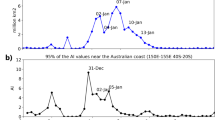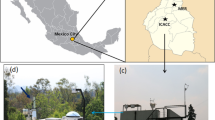Abstract
A curious instance of atmospheric pollution came to my notice on November 26 while walking from Hayfield into Edale over the central watershed of England in the Peak of Derbyshire. Below 1500 ft. on the western side there was hazy sunshine with a rime frost, but at this level we entered a thin cloud, with a temperature scarcely below freezing point, formed by a steady easterly wind blowing over the Peak plateau from the east. Friends in Edale informed us that these conditions had obtained since the morning of the previous day, and the hoar-frost thus formed was peculiar; the stream-lines of air-flow round stones were clearly mapped by curling lines of ice, while every blade of grass and stem of Juncus bore a deposit of ice-crystals which resembled the blade of a knife, the knife-edge pointing up-wind and the parent leaf forming the back.
This is a preview of subscription content, access via your institution
Access options
Subscribe to this journal
Receive 51 print issues and online access
$199.00 per year
only $3.90 per issue
Buy this article
- Purchase on Springer Link
- Instant access to full article PDF
Prices may be subject to local taxes which are calculated during checkout
Similar content being viewed by others
Author information
Authors and Affiliations
Rights and permissions
About this article
Cite this article
BALLS, W. The Smoke-veil. Nature 108, 499–500 (1921). https://doi.org/10.1038/108499a0
Issue Date:
DOI: https://doi.org/10.1038/108499a0
Comments
By submitting a comment you agree to abide by our Terms and Community Guidelines. If you find something abusive or that does not comply with our terms or guidelines please flag it as inappropriate.



